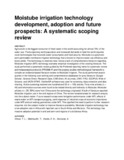Please use this identifier to cite or link to this item:
http://ir-library.mmust.ac.ke:8080/xmlui/handle/123456789/1563Full metadata record
| DC Field | Value | Language |
|---|---|---|
| dc.contributor.author | Dirwai, T. L | - |
| dc.contributor.author | Mabhaudhi, T | - |
| dc.contributor.author | Kanda, E. K | - |
| dc.contributor.author | Senzanje, A. | - |
| dc.date.accessioned | 2021-06-03T13:59:46Z | - |
| dc.date.available | 2021-06-03T13:59:46Z | - |
| dc.date.issued | 2021-02-01 | - |
| dc.identifier.uri | https://doi.org/10.1016/j.heliyon.2021.e06213 | - |
| dc.identifier.uri | https://www.sciencedirect.com/science/article/pii/S2405844021003182 | - |
| dc.identifier.uri | http://r-library.mmust.ac.ke/123456789/1563 | - |
| dc.description.abstract | Agriculture is the biggest consumer of fresh water in the world accounting for almost 70% of the water use. The burgeoning world population and increased demands to feed the world requires novel technologies that reconcile water consumption and food security. Moistube is a polymeric semi-permeable membrane irrigation technology that is known to improve water use efficiency and boost yields. The technology is relatively new, hence a lack of comprehensive literature regarding Moistube irrigation (MTI) technology warrants empirical investigation of the existing literature. The study performed a systematic review guided by the Preferred reporting items for systematic review and meta-analysis protocols (PRISMA-P) and the scoping studies methodological framework to compile an evidence-based literature review on Moistube irrigation. The study performed search queries in the following over-arching and comprehensive databases for grey literature: Google Scholar, Science Direct, Research Gate, CAB direct, All Journals, CNKI, FAO, SCOPUS, Web of Science, and UKZN-EFWE. DistillerSR software was used for screening, data extraction and data charting. Article screening retained one hundred and 55 (n = 155) articles. Forty-nine articles (n = 49) and information sources were found to be related directly and indirectly to Moistube. Moistube articles (n = 29, 59%) were from China were the technology originated. A bulk of literature reported Moistube irrigation use in the arid regions of China. The review revealed areas for research enquiry into the subject matter. Future research areas were fertigation performance under MTI, effects of waste-water on MTI nanopore plugging, yield response of industrial crops of economic importance under MTI and soil wetting geometries under MTI. This signified the need to perform further research enquiries into the subject matter to improve literature availability. Moistube irrigation technology has a low adoption rate in Africa with reported use in South Africa and Morocco. The technology has massive adoption potential in arid and semi-arid regions of sub Sahara Africa. | en_US |
| dc.language.iso | en | en_US |
| dc.publisher | Heliyon | en_US |
| dc.subject | Moistube, irrigation technology, adoption, future prospects | en_US |
| dc.title | Moistube irrigation technology development, adoption and future prospects | en_US |
| dc.title.alternative | A systematic scoping review | en_US |
| dc.type | Article | en_US |
| Appears in Collections: | Gold Collection | |
Files in This Item:
| File | Description | Size | Format | |
|---|---|---|---|---|
| Moistube irrigation technology development.pdf | 180.57 kB | Adobe PDF |  View/Open |
Items in DSpace are protected by copyright, with all rights reserved, unless otherwise indicated.
